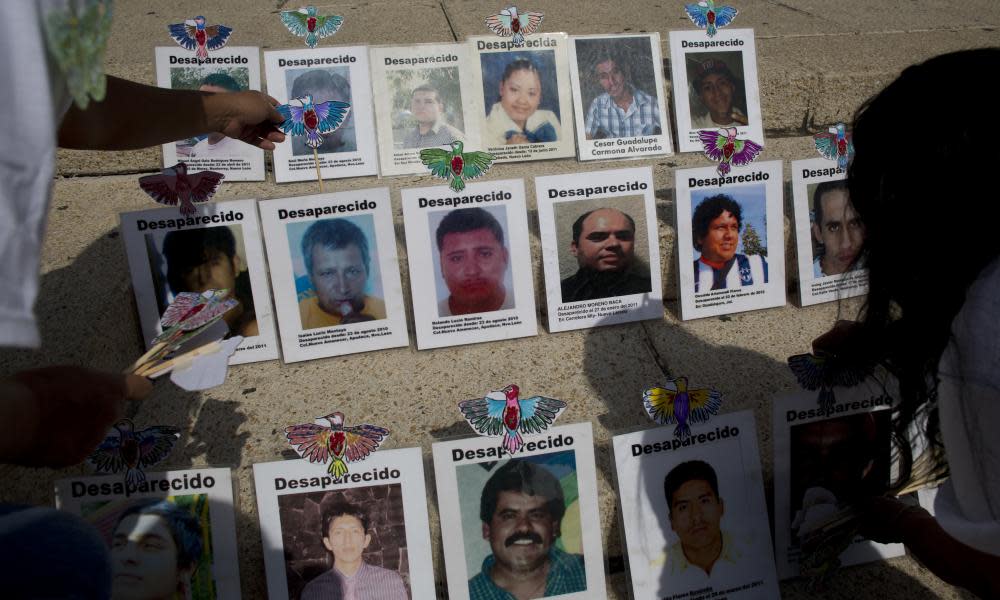Mexico: bounty raised over $1m on drug cartel kingpin 'El Mencho'

Mexican authorities have raised the bounty on one of the country’s most bloodthirsty cartel kingpins – Nemesio Oseguera Cervantes, known as “El Mencho” – whose underlings have deployed waves of violence to thwart attempts at detaining him.
Officials announced on Wednesday that they are offering 30m pesos ($1.56m) for information on Oseguera, leader of the powerful Jalisco New Generation Cartel (CJNG,) which deals heavily in making and moving methamphetamines, and has expanded its reach across Mexico as rival criminal groups splinter.
The announcement came as the US Drug Enforcement Administration and Mexican officials prepared to unveil plans to deepen cooperation against the cartels. The new strategy includes closer scrutiny on cartel finances and a new enforcement group, which will focus on international investigations.
“The new game plan is … pick up the speed and arrest more people,
faster,” Matthew G Donahue, director for the DEA’s North and Central American Region, told the AP.
Oseguera is one of the most powerful figures still on the loose, having eluded capture for nearly a decade. The CJNG has launched coordinated shows of strength across western Jalisco state by blocking roads with hijacked vehicles as federal forces close in on its leader.
Why did Mexico launch its war on drugs?
On 10 December 2006, president Felipe Calderón, launched Mexico’s war on drugs by sending 6,500 troops into his home state of Michoacán, where rival cartels were engaged in tit-for-tat massacres.
Calderón declared war eight days after taking power – a move widely seen as an attempt to boost his own legitimacy after a bitterly contested election victory. Within two months, around 20,000 troops were involved in operations across the country.
What has the war cost so far?
The US has donated at least $1.5bn through the Merida Initiative since 2008, while Mexico has spent at least $54bn on security and defence since 2007. Critics say that this influx of cash has helped create an opaque security industry open to corruption at every level.
But the biggest costs have been human: since 2007, around 230,000 people have been murdered and more than 28,000 reported as disappeared. Human rights groups have also detailed a vast rise in human rights abuses by security forces.
As the cartels have fractured and diversified, other violent crimes such as kidnapping and extortion have also surged. In addition, hundreds of thousands of people have been displaced by violence.
What has been achieved?
Improved collaboration between the US and Mexico has resulted in numerous high-profile arrests and drug busts. Officials say 25 of the 37 drug traffickers on Calderón’s most-wanted list have been jailed, extradited to the US or killed, although not all of these actions have been independently corroborated.
The biggest victory – and most embarrassing blunder – under Peña Nieto’s leadership was the recapture, escape and another recapture of Joaquín “El Chapo” Guzmán, leader of the Sinaloa cartel.
While the crackdown and capture of kingpins has won praise from the media and US, it has done little to reduce the violence.
How is the US involved?
Mexico’s decade-long war on drugs would never have been possible without the huge injection of American cash and military cooperation under the Merida Initiative. The funds have continued to flow despite growing evidence of serious human rights violations.
His wife, Rosalinda González Valencia – who is accused of overseeing the cartel’s finances – was arrested in late May in suburban Guadalajara.
The CJNG emerged in 2010 after a prominent Sinaloa Cartel boss, Nacho Coronel, was killed by federal forces and Oseguera won the ensuing power struggle.
The cartel has earned notoriety for its violence and its willingness to confront state forces in open battle: CJNG gunmen are accused of ambushing a police convoy in an attack which killed 15 officers. They later shot down an army helicopter.
Analysts say the cartel has disputed territories previously controlled by the Sinaloa Cartel, whose leader Joaquín “El Chapo” Guzmán was captured in 2016 and extradited to the United States the following year.
But recently the CJNG has itself reportedly split, leading to more fighting between former allies.
More than 200,000 have been killed and 30,000 have gone missing in Mexico’s militarized war on drugs which was launched in December 2006. Violence reached record levels in 2017 with 29,168 homicides registered.
President-elect Andrés Manuel López Obrador has promised to rethink the country’s anti-narcotics strategy by offering amnesties to low-level figures forced into the illegal drugs business and tackling what he considers the root causes of crime: poverty and corruption.
His nominee for public security secretary, Alfonso Durazo, has promised to discard the so-called “kingpin strategy” of capturing or killing senior cartel figures, telling Mexican media on Wednesday: “It hasn’t produced the best results.”
Critics of the strategy say that it only create more violence as new crime bosses emerge and fight for the spoils of the drug market.
“Of 122 prime targets, 120 have been detained. Insecurity has increased, however,” Durazo said. “For us it is much more important to pursue narcotics traffickers’ money rather than narcotics traffickers themselves, because what gives narcos their operational ability … are resources to corrupt and operate.”
But Donahue defended the kingpin strategy, saying authorites in the two countries will “always go after the top dog” in a cartel and “always go after the entire organization”.

 Yahoo News
Yahoo News 
